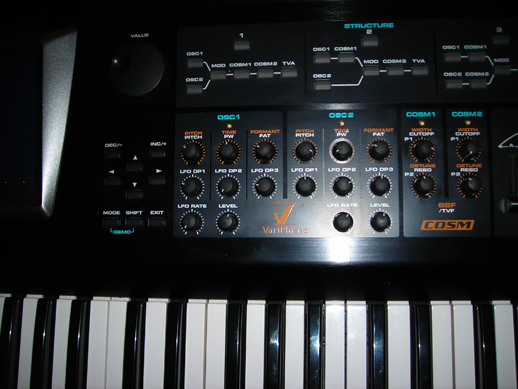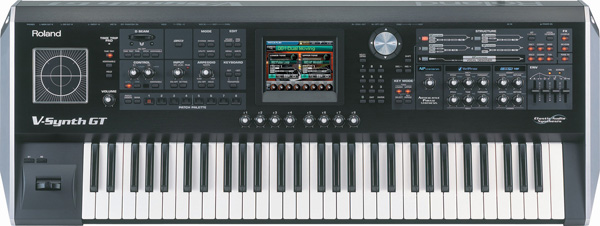Roland V-Synth

Roland V-Synth

Roland V-Synth
image - © synthlearn.com
Overview:
Every so often, it seems that a synth manufacturer will pull a special product out of the bag, something that breaks with tradition and points synthesis in a new direction. The Roland V-Synth is one such synth. It was designed to give both a wide array of possibilities for sound design, and also an unusual set of controls for live performance. The V-Synth is not "normal" - it was aimed at the kind of synth player who likes to get "under the hood" and create wild new sounds.
It's really a programmer's machine - a sonic experimenter's dream. But one of the rare attributes of the V-Synth is that the designers have struck a very good balance between in-depth programming and hands-on experimentation. In other words, there's enormous depth for the type of programmer who wishes to be "scientific" about their sound manipulation, and there are endless possibilities for the type of programmer who simply wants to get their hands on the knobs, go wild and see what will happen. Using either strategy - or a bit of both - will result in new, unheard of and unique sounds.
The V-Synth is not a typical "workstation". Although it has an in-depth arpeggiator and good-sized touch-screen control, there is no sequencer. It's for sound design and performance - but if you are looking for something to make complete compositions and arrangements, you will find yourself wishing for other music gear to accompany your V-Synth.
The original V-Synth was released in 2003. The XT (rackmount / desktop) version appeared in 2005 and added built-in "V-Cards". These comploetely change the architecture of the synth, giving you D-50 and Vocal Designer options. Finally the GT (flagship) version appeared in 2007. The GT version includes Roland's "Vocal Designer" feature. This uses "Articulative Phrase Synthesis" to generate unique sonic and expressive nuances. Also included on the GT are extra assignable control knobs and an expanded architecture.
Roland V-Synth - More Pics:

Roland V-Synth -
detail of some of the
controls

Roland V-Synth
GT
Roland V-Synth Features:
The V-Synth has so many features that to list them all would take up too much space! It has most of the features that you would expect from a modern synth - multiple oscillator types, advanced filters, envelopes, and on-board FX. Here are some of the interesting, cool and unusual features:
Build: One thing I liked about the V-Synth is that it was solidly built. It's housed in a metal case, not plastic - and unlike many other synths, it has a general air of solidity to it. This is especially important for the pro user who may be taking the machine on the road and demanding that it survives.
Time Trip Pad: This square touch-sensitive pad (on the left of the machine) acts as an X-Y axis controller, performing in a similar manner to a joystick. Various parameters can be assigned to the pad - which can function both in XY mode and as a kind of "scrub" control for samples using circular motion.
D-Beam: Another live performance control, this responds to movements in the air above it, something like a theremin - with assignable control. This is lots of fun - but one criticism is that if you lean too far forward when you are playing, you might accidentally trigger the D-Beam with your head. Also if you have the V-Synth in a multi-tier keyboard setup, you might accidentally trigger the D-Beam when reaching for another synth positioned above / behind the V-Synth. I have done this in live performance and caused wild detuning of the sound I was playing.
Patches: Space for 512 sounds - with all patches overwriteable. There's also a "Patch Pallette" feature where you can pick up to 8 of your favorite sounds and have them available for instant recall. (Like having "speed dial" - can be invaluable during a live show!)
Time Trip: This uses Roland's VariPhrase processing to manipulate a sound's harmonic content in unprecedented ways. Great for '"freezing" drum loops into strange, glassy shards of sound.
External Audio Processing: Patch in another sound source to the external sound inputs and process it through the V-Synth filters etc..
USB: Use the handy USB interface to back up your work to a computer, update the software, to import new samples or sound banks downloaded from the internet.
Criticism: If there's one criticism I have to make of the V-Synth, it's that its capabilities as a sampler are limited. The sampling option was really included so as to give the programmer the ability to load new waveforms / sounds and process them through the unique V-Synth architecture. It was never really meant to do the things an "ordinary" sampler does, such as load a large bank of sounds, map them to different keys and trigger them as part of a composition. There are limitations on both the sample memory and the process for rapid loading of sample banks.
Prices: A used V-Synth is often considered to be good value for the money paid. Expect to pay around $800-1000 on eBay for a used "original" V-Synth. A V-Synth GT seems to be priced currently (July 2010) from around $2200 used to $3300 new.
Roland V-Synth Reviews:
V-Synth GT review on tweakheadz.com
V-Synth "Original" review on Sound On
Sound
Great, in depth review of the original V-Synth from Electronic Musician
Roland V-Synth Resources and other links:
Official Roland V-Synth Web Site (English)
User Manual, Version 2.0 Drivers & more
V-Synth on Vintage Synth Explorer
Roland V-Synth Sounds:
There are various free V-Synth sound banks floating around the internet, here are a couple:
Roland V-Synth GT official Free sound set - over 450 sounds including classic analog emulations
Official V-Synth Refill Patches
Roland V-Synth Videos:
Great demo of one of the patches on the V-Synth GT
Demo of some original V-Synth 2.0 patches.
Fun V-Synth GT demo, includes demo of D-Beam and Time Trip Pad features.



